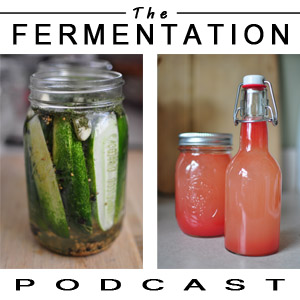Today it’s all about salt. It’s just you and me and I talk about the many types of salt is available to you out there, some of the basics when it comes to making brines, and weight ratios you should know and keep in mind when you’re making and following recipes.
You would think that the topic of salt is a simple one but did you know there’s added ingredients in most table salt? What does that do to your ferments and more importantly, are there any healthy salts that could give you a boost in nutrition with it’s added minerals?
When I first started, I began using sea salt and skipped the table salt immediately but I had no idea that there were so many salts out there that you can consider for so many different reasons. Even the topic of iodine deficiency is a big one when it comes to that popular NaCl.
In any case, when creating a starter culture, you want to give it the best it can have so how about giving today’s show a listen and finding out what kinds of salt to use it lactic acid fermentation and pickling?
TOPICS INCLUDED IN TODAY’S FERMENTATION PODCAST:
- Salt Basics
- Why should you use salt in fermentation?
- Does salt help or hurt bacteria when making things like pickles or sauerkraut?
- Using salt in fermentation and what it does to aerobic yeasts and mold
- Can you use too much salt when fermenting things?
- A discussion on the several different types of salt and what types of salt should you use for fermentation?
- Some of the many salts talked about include:
- Table salt
- Iodized table salt
- Pickling salt
- Kosher Sea
- Fleur de sel or “flower of salt
- Sel gris or “grey salt” also known as Celtic sea salt
- Pink Himalayan salt
- Black salt (also known as Kala Namak)
- Hawaiian sea salt
- Salt Weights & Brine Basics
- The weight of salt depends on 3 things – how coarse or fine the salt was ground, the density of the salt, and what the moisture content is
- My 3 different methods for calculating out salt ratios
- The exact scientific method of weights using a gram scale to measure salinity percentages
- Measuring salt by measuring spoon anyways and stick to it method
- The salt to taste method
- General Rules of Salinity Ratios
- Typical salinity ratios you’ll like for fermenting vegetables
- Keeping vegetables more crisp with more salt
- A quick word on much higher salinity ratios for other ferments like meat, different cheeses, brining olives, making fish sauce, or making a batch of miso
- The affect of higher the salinity of the brine you’re making and the longer the fermentation is going to take
- Decreasing the salt by adding more flavor with herbs, aromatics like garlic and onions and also lemon juice to increase the acidity
- Backslopping
- And of course, when fermenting vegetables, keep it below the brine level
LINKS FOR TODAY’S SHOW:
- Subscribe to Email (to get updates on blogs & new shows)
- Subscribe on iTunes
- Subscribe on Stitcher Radio (Android, iPhone, etc.)
- Like us on Facebook
- Follow us on Twitter
- Follow our boards on Pinterest
I’d love to hear your thoughts on today’s show so be sure to comment below or if you have an idea for the show, email me at paul at fermentationpodcast.com or just click on the Contact button on top of this page and fill out the form. I look forward to hearing from you!
 Episode 10 - Types of Salt, Brine Basics, and Weight Ratios in Fermentation Play Now | Play in Popup | Download
Episode 10 - Types of Salt, Brine Basics, and Weight Ratios in Fermentation Play Now | Play in Popup | Download



2 comments
1 pings
Paul, I’ve thoroughly enjoyed the Mark Campbell interview for the third time. Nice job !
I’ll order a crock.
Gary Johnson
Author
Thanks Gary!
Mark really has some amazing stuff. It’s great to see him making a career move over to ceramics now. He’s definitely good at it! You’ll have to send me a picture when you get your crock so I can see what yours looks like. He has so many different designs.
[…] « Episode 10 – Types of Salt, Brine Basics, and Weight Ratios in Fermentation […]